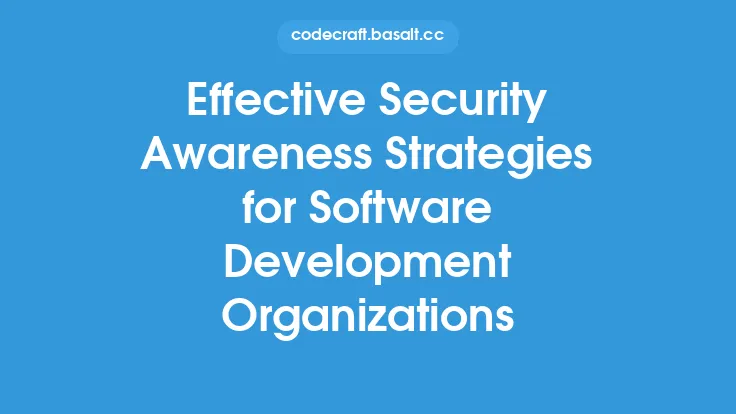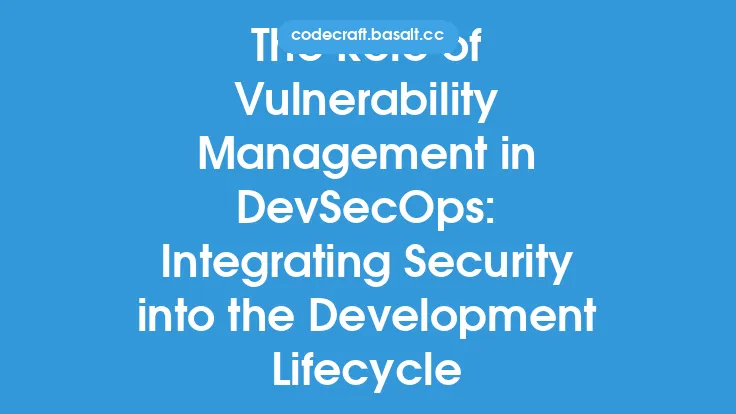Agile software development methodologies have become the norm in the industry, with their iterative and incremental approach to delivering working software in short cycles. However, this approach can sometimes lead to security being an afterthought, rather than an integral part of the development process. Integrating security awareness into agile software development methodologies is crucial to ensure that security is not compromised in the pursuit of speed and flexibility. In this article, we will explore the importance of security awareness in agile software development, and provide guidance on how to integrate it into the development process.
Introduction to Agile Security Awareness
Agile security awareness refers to the practice of incorporating security considerations into every stage of the agile software development lifecycle. This includes identifying potential security risks, implementing security controls, and continuously monitoring and improving the security posture of the application. Agile security awareness is not a one-time activity, but rather a continuous process that requires the active participation of all team members, including developers, testers, and project managers. By integrating security awareness into the agile development process, organizations can reduce the risk of security breaches, protect sensitive data, and ensure compliance with regulatory requirements.
Integrating Security into Agile Methodologies
There are several ways to integrate security into agile methodologies, including:
- Security-focused user stories: Security requirements can be incorporated into user stories, which are used to define the functional requirements of the application. For example, a user story might include a requirement for authentication and authorization, or for data encryption.
- Security testing: Security testing can be integrated into the agile testing process, using techniques such as penetration testing, vulnerability scanning, and security-focused unit testing.
- Security reviews: Regular security reviews can be conducted to identify potential security risks and vulnerabilities, and to ensure that security controls are in place and effective.
- Security training: Developers and other team members can receive security training, to ensure that they have the knowledge and skills needed to implement secure coding practices and identify potential security risks.
Agile Security Awareness Best Practices
There are several best practices that organizations can follow to integrate security awareness into their agile software development methodologies, including:
- Implement secure coding practices: Developers should follow secure coding practices, such as input validation, error handling, and secure data storage.
- Use security frameworks and libraries: Security frameworks and libraries, such as OWASP ESAPI, can provide pre-built security controls and guidance on secure coding practices.
- Conduct regular security testing: Regular security testing, including penetration testing and vulnerability scanning, can help identify potential security risks and vulnerabilities.
- Continuously monitor and improve: The security posture of the application should be continuously monitored and improved, using techniques such as security information and event management (SIEM) systems and continuous integration/continuous deployment (CI/CD) pipelines.
Technical Considerations for Agile Security Awareness
There are several technical considerations that organizations should be aware of when integrating security awareness into their agile software development methodologies, including:
- Secure coding languages: Some programming languages, such as Java and C#, have built-in security features and libraries that can help prevent common security vulnerabilities.
- Security testing tools: There are a range of security testing tools available, including open-source tools such as OWASP ZAP and Burp Suite, and commercial tools such as Veracode and Checkmarx.
- Cloud security: Cloud-based applications require special security considerations, including data encryption, access controls, and compliance with cloud security standards such as PCI-DSS and HIPAA.
- Container security: Containerized applications require special security considerations, including secure container configuration, network segmentation, and continuous monitoring and scanning.
Measuring the Effectiveness of Agile Security Awareness
Measuring the effectiveness of agile security awareness is crucial to ensuring that security is integrated into the development process and that security risks are identified and mitigated. There are several metrics that organizations can use to measure the effectiveness of agile security awareness, including:
- Number of security vulnerabilities: The number of security vulnerabilities identified and remediated can be used to measure the effectiveness of security testing and secure coding practices.
- Time-to-remediate: The time it takes to remediate security vulnerabilities can be used to measure the effectiveness of the security response process.
- Security incident response: The effectiveness of the security incident response process can be measured by tracking the number of security incidents, the time-to-respond, and the time-to-remediate.
- Security awareness training: The effectiveness of security awareness training can be measured by tracking the number of employees who have received training, and the number of security incidents that have been prevented or detected.
Conclusion
Integrating security awareness into agile software development methodologies is crucial to ensuring that security is not compromised in the pursuit of speed and flexibility. By incorporating security considerations into every stage of the agile development process, organizations can reduce the risk of security breaches, protect sensitive data, and ensure compliance with regulatory requirements. By following best practices, using security frameworks and libraries, and continuously monitoring and improving the security posture of the application, organizations can ensure that security is an integral part of the agile development process.





